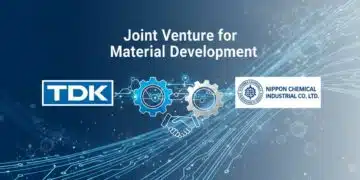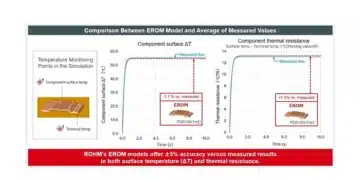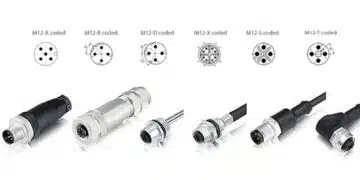Paul Martin from SpecialChem company put together a comprehensive article on “Coefficient of Linear Thermal Expansion (CLTE)” which includes Min Value (°C) & Max Value (°C) table. This may be quite useful when evaluation various plastic polymer material properties and its thermal modelling.
What happens when material is heated?
Under the effects of increasing temperature any material will expand. This can lead to significant changes in dimensions, to part war-page or to internal stress.
The Coefficient of Linear Thermal Expansion (CLTE often referred to as “α”) is a material property which characterizes the ability of a plastic to expand under the effect of temperature elevation. It tells you how much the developed part will remain dimensionally stable under temperature variations.
The linear coefficient ‘CLTE or α’ for plastic and polymer materials is calculated as:
α = ΔL / (L0 * ΔT)
Where:
- α is coefficient of linear thermal expansion per degree Celsius
- ΔL is change in length of test specimen due to heating or to cooling
- L0 is the original length of specimen at room temperature
- ΔT is temperature change, °C, during test
Therefore, α is obtained by dividing the linear expansion per unit length by the change in temperature. When reporting the mean coefficient of thermal expansion, the temperature ranges must be specified.
Applications include:
The thermal expansion difference develops internal stresses and stress concentrations in the polymer, which allows premature failure to occur. Hence, CLTE is important for the economics of production as well as the quality and functioning of products.
- It is required for design purposes. Thermal expansion is often used to predict shrinkage in injection molded parts … » Watch video to avoid plastic quality crashes
- It helps determine dimensional behavior of structures subject to temperature changes
- It also determines thermal stresses that can occur, and cause failure of a solid artifact composed of different materials when it is subjected to a temperature excursion (specially to predict efficient material bonding or while using plastics with metals)
Check out more on Linear Coefficient of Thermal Expansion:
- CTE, Linear Values of Several Plastics
- Main Techniques Used to Measure CTE, Linear
- Factors Affecting Thermal Expansion Coefficient Measurements
How to Measure Coefficient of Linear Thermal Expansion?
Most widely used standards to measure coefficient of linear thermal expansion in plastics (thermoplastics and thermosetting materials, filled or unfilled, in the form of sheet or molded parts) are ASTM D696, ASTM E831, ASTM E228 and ISO 11359.
The main techniques used for CTE measurements are:
- Dilatometry
- Interferometry and
- Thermomechanical analysis
(of course there exist several other methods as well, but they are not discussed here)
Dilatometry Technique
It is the widely used technique in which specimen is heated in a furnace and displacement of the ends of the specimen are transmitted to a sensor by means of push rod. Push rods may be of the vitreous silica type, the high-purity alumina type, or the isotropic graphite type.
ASTM D696 – This test method covers determination of the coefficient of linear thermal expansion for plastic materials having coefficients of expansion greater than 1 µm/(m.°C) by use of a vitreous silica dilatometer. The nature of most plastics and the construction of the dilatometer make −30 to +30°C (−22°F to +86°F) a convenient temperature range for linear thermal expansion measurements of plastics. This range covers the temperatures in which plastics are most commonly used.
ASTM E228 – This test method shall be used for temperatures other than −30°C to 30°C to determine linear thermal expansion of solid materials with a push-rod dilatometer
Thermomechanical Analysis (TMA)
The measurements are made using a thermomechanical analyzer consisting of a specimen holder and a probe that transmits changes in length to a transducer that translates movements of the probe into an electrical signal.
ASTM E831 (and ISO 11359-2) – These methods are applicable applicable to solid materials that exhibit sufficient rigidity over the test temperature range. The lower limit for CTE with this method is 5 × 10-6/K (2.8 × 10-6/°F), but it may be used at lower or negative expansion levels with decreased accuracy and precision. It is applicable to the temperature range from −120 to 900°C. The temperature range may be extended depending upon the instrumentation and calibration materials used.
Interferometry
With optical interference techniques, displacement of the specimen ends is measured in terms of the number of wavelengths of monochromatic light. Precision is significantly greater than with dilatometry, but because the technique relies on the optical reflectance of the specimen surface, interferometry is not used much above 700 °C (1290 °F).
ASTM E289 provides a standard method for linear thermal expansion of rigid solids with interferometry that is applicable from –150 to 700 °C (–240 to 1290 °F). It is is more applicable to materials having low or negative CTE in the range of <5 × 10-6/K (2.8 × 10-6/°F) or where only limited lengths of thickness of other higher expansion coefficient materials are available.
Factors Affecting Thermal Expansion Coefficient Measurements of Plastics
- Fibers and other fillers significantly reduce thermal expansion. The degree of anisotropy of the filler and the filler orientation pose great impact on the linear coefficient of thermal expansion
- W.r.t the temperature, the magnitude of the CTE increases with rising temperature
- Molecular orientation also affects the thermal expansion of plastics. The thermal expansion is often affected by the cooling time during processing. This is especially true with semi-crystalline polymers whose crystallization process requires time
Find commercial grades matching your mechanical properties target using “Property Search – CTE, Linear” filter in Omnexus Plastics Database:
Linear Coefficient of Thermal Expansion Values of Several Plastics
The Coefficient of Linear Thermal Expansion (Or Linear Coefficient of Thermal Expansion) lies between (in the service temperature range for each case):
- Ca. 0.6 x 10-4 to 2.3 x 10-4 K-1 for most of the thermoplastics
- Ca. 0.2 x 10-4 to 0.6 x 10-4 K-1 for thermosets
| Polymer Name | Min Value (10-5 /°C) | Max Value (10-5 /°C) |
| ABS – Acrylonitrile Butadiene Styrene | 00 | 15.00 |
| ABS Flame Retardant | 6.00 | 9.00 |
| ABS High Heat | 6.00 | 10.00 |
| ABS High Impact | 6.00 | 13.00 |
| ABS/PC Blend – Acrylonitrile Butadiene Styrene/Polycarbonate Blend | 4.00 | 5.00 |
| ABS/PC Blend 20% Glass Fiber | 1.80 | 2.00 |
| ABS/PC Flame Retardant | 3.00 | 4.00 |
| ASA – Acrylonitrile Styrene Acrylate | 6.00 | 11.00 |
| ASA/PC Blend – Acrylonitrile Styrene Acrylate/Polycarbonate Blend | 7.00 | 9.00 |
| ASA/PC Flame Retardant | 7.00 | 8.00 |
| ASA/PVC Blend – Acrylonitrile Styrene Acrylate/Polyvinyl Chloride Blend | 0.00 | 9.00 |
| CA – Cellulose Acetate | 8.00 | 18.00 |
| CAB – Cellulose Acetate Butyrate | 10.00 | 17.00 |
| Celllulose Diacetate- Pearlescent Films | 2.15 | 2.15 |
| Celllulose Diacetate-Gloss Film | 2.15 | 2.15 |
| Celllulose Diacetate-Integuard Films | 1.00 | 1.50 |
| Celllulose Diacetate-Matt Film | 2.15 | 2.15 |
| Cellulose Diacetate -Window Patch Film (Food Grade) | 2.15 | 2.15 |
| Cellulose Diacetate-Clareflect metallized film | 1.50 | 1.50 |
| Cellulose diacetate-Flame retardant Film | 0.64 | 0.64 |
| Cellulose Diacetate-High Slip Film | 2.15 | 2.15 |
| Cellulose Diacetate-High Slip Film | 2.15 | 2.15 |
| CP – Cellulose Proprionate | 10.00 | 17.00 |
| COC – Cyclic Olefin Copolymer | 6.00 | 7.00 |
| CPVC – Chlorinated Polyvinyl Chloride | 6.00 | 8.00 |
| CTFE | 6.00 | 9.00 |
| EVA – Ethylene Vinyl Acetate | 16.00 | 20.00 |
| FEP – Fluorinated Ethylene Propylene | 8.00 | 10.00 |
| HDPE – High Density Polyethylene | 6.00 | 11.00 |
| HIPS – High Impact Polystyrene | 5.00 | 20.00 |
| HIPS Flame Retardant V0 | 5.00 | 15.00 |
| Ionomer (Ethylene-Methyl Acrylate Copolymer) | 10.00 | 17.00 |
| LCP – Liquid Crystal Polymer | 0.30 | 7.00 |
| LCP Carbon Fiber-reinforced | 0.10 | 6.00 |
| LCP Glass Fiber-reinforced | 0.10 | 6.00 |
| LCP Mineral-filled | 0.90 | 8.00 |
| LDPE – Low Density Polyethylene | 10.00 | 20.00 |
| MABS (Transparent Acrylonitrile Butadiene Styrene) | 8.00 | 11.00 |
| PA 11 – (Polyamide 11) 30% Glass fiber reinforced | 3.00 | 15.00 |
| PA 11, Conductive | 9.00 | 15.00 |
| PA 11, Flexible | 9.00 | 15.00 |
| PA 11, Rigid | 9.00 | 15.00 |
| PA 12 (Polyamide 12), Conductive | 9.00 | 15.00 |
| PA 12, Fiber-reinforced | 9.00 | 15.00 |
| PA 12, Flexible | 9.00 | 15.00 |
| PA 12, Glass Filled | 9.00 | 15.00 |
| PA 12, Rigid | 9.00 | 15.00 |
| PA 46, 30% Glass Fiber | 2.00 | 2.00 |
| PA 6 – Polyamide 6 | 5.00 | 12.00 |
| PA 6-10 – Polyamide 6-10 | 6.00 | 10.00 |
| PA 66 – Polyamide 6-6 | 5.00 | 14.00 |
| PA 66, 30% Glass Fiber | 2.00 | 3.00 |
| PA 66, 30% Mineral filled | 4.00 | 5.00 |
| PA 66, Impact Modified, 15-30% Glass Fiber | 2.00 | 3.00 |
| PA 66, Impact Modified | 5.00 | 14.00 |
| PAI – Polyamide-Imide | 3.00 | 4.00 |
| PAI, 30% Glass Fiber | 1.00 | 2.00 |
| PAI, Low Friction | 2.00 | 3.00 |
| PAN – Polyacrylonitrile | 6.00 | 7.00 |
| PAR – Polyarylate | 5.00 | 8.00 |
| PARA (Polyarylamide), 30-60% glass fiber | 1.40 | 1.80 |
| PBT – Polybutylene Terephthalate | 6.00 | 10.00 |
| PBT, 30% Glass Fiber | 2.00 | 5.00 |
| PC (Polycarbonate) 20-40% Glass Fiber | 2.00 | 4.00 |
| PC (Polycarbonate) 20-40% Glass Fiber Flame Retardant | 2.00 | 4.00 |
| PC – Polycarbonate, high heat | 7.00 | 9.00 |
| PCL – Polycaprolactone | 16.00 | 17.00 |
| PCTFE – Polymonochlorotrifluoroethylene | 4.00 | 7.00 |
| PE – Polyethylene 30% Glass Fiber | 5.00 | 5.00 |
| PEEK – Polyetheretherketone | 4.70 | 10.80 |
| PEEK 30% Carbon Fiber-reinforced | 1.50 | 1.50 |
| PEEK 30% Glass Fiber-reinforced | 1.50 | 2.20 |
| PEI – Polyetherimide | 5.00 | 6.00 |
| PEI, 30% Glass Fiber-reinforced | 2.00 | 2.00 |
| PEI, Mineral Filled | 2.00 | 5.00 |
| PEKK (Polyetherketoneketone), Low Cristallinity Grade | 77.00 | 77.00 |
| PESU – Polyethersulfone | 5.00 | 6.00 |
| PESU 10-30% glass fiber | 2.00 | 3.00 |
| PET – Polyethylene Terephtalate | 6.00 | 8.00 |
| PET, 30% Glass Fiber-reinforced | 2.00 | 5.00 |
| PET, 30/35% Glass Fiber-reinforced, Impact Modified | 1.50 | 2.00 |
| PETG – Polyethylene Terephtalate Glycol | 8.00 | 8.00 |
| PFA – Perfluoroalkoxy | 8.00 | 12.00 |
| PI – Polyimide | 5.50 | 5.50 |
| PLA – Polylactide | 8.50 | 8.50 |
| PMMA – Polymethylmethacrylate/Acrylic | 5.00 | 9.00 |
| PMMA (Acrylic) High Heat | 4.00 | 9.00 |
| PMMA (Acrylic) Impact Modified | 5.00 | 9.00 |
| POM – Polyoxymethylene (Acetal) | 10.00 | 15.00 |
| POM (Acetal) Impact Modified | 12.00 | 13.00 |
| POM (Acetal) Low Friction | 10.00 | 12.00 |
| POM (Acetal) Mineral Filled | 8.00 | 9.00 |
| PP – Polypropylene 10-20% Glass Fiber | 4.00 | 7.00 |
| PP, 10-40% Mineral Filled | 3.00 | 6.00 |
| PP, 10-40% Talc Filled | 4.00 | 8.00 |
| PP, 30-40% Glass Fiber-reinforced | 2.00 | 3.00 |
| PP (Polypropylene) Copolymer | 7.00 | 17.00 |
| PP (Polypropylene) Homopolymer | 6.00 | 17.00 |
| PP, Impact Modified | 7.00 | 17.00 |
| PPA – Polyphthalamide | 5.40 | 5.40 |
| PPA, 30% Mineral-filled | 7.10 | 7.20 |
| PPA, 33% Glass Fiber-reinforced | 1.00 | 1.20 |
| PPA, 33% Glass Fiber-reinforced – High Flow | 0.90 | 1.10 |
| PPA, 45% Glass Fiber-reinforced | 0.73 | 0.75 |
| PPE – Polyphenylene Ether | 3.00 | 7.00 |
| PPE, 30% Glass Fiber-reinforced | 1.50 | 2.50 |
| PPE, Flame Retardant | 3.00 | 7.00 |
| PPE, Impact Modified | 4.00 | 8.00 |
| PPE, Mineral Filled | 2.00 | 5.00 |
| PPS – Polyphenylene Sulfide | 3.00 | 5.00 |
| PPS, 20-30% Glass Fiber-reinforced | 1.00 | 4.00 |
| PPS, 40% Glass Fiber-reinforced | 1.00 | 3.00 |
| PPS, Conductive | 1.00 | 9.00 |
| PPS, Glass fiber & Mineral-filled | 1.00 | 2.00 |
| PS (Polystyrene) 30% glass fiber | 3.50 | 3.50 |
| PS (Polystyrene) Crystal | 5.00 | 8.00 |
| PS, High Heat | 6.00 | 8.00 |
| PSU – Polysulfone | 5.00 | 6.00 |
| PSU, 30% Glass fiber-reinforced | 2.00 | 3.00 |
| PSU Mineral Filled | 3.00 | 4.00 |
| PTFE – Polytetrafluoroethylene | 7.00 | 20.00 |
| PTFE, 25% Glass Fiber-reinforced | 7.00 | 10.00 |
| PVC (Polyvinyl Chloride), 20% Glass Fiber-reinforced | 2.00 | 4.00 |
| PVC, Plasticized | 5.00 | 20.00 |
| PVC, Plasticized Filled | 7.00 | 25.00 |
| PVC Rigid | 5.00 | 18.00 |
| PVDC – Polyvinylidene Chloride | 10.00 | 20.00 |
| PVDF – Polyvinylidene Fluoride | 8.00 | 15.00 |
| SAN – Styrene Acrylonitrile | 6.00 | 8.00 |
| SAN, 20% Glass Fiber-reinforced | 2.00 | 4.00 |
| SMA – Styrene Maleic Anhydride | 7.00 | 8.00 |
| SMA, 20% Glass Fiber-reinforced | 2.00 | 4.00 |
| SMA, Flame Retardant V0 | 2.00 | 6.00 |
| SRP – Self-reinforced Polyphenylene | 3.00 | 3.00 |
| UHMWPE – Ultra High Molecular Weight Polyethylene | 13.00 | 20.00 |
| XLPE – Crosslinked Polyethylene | 10.00 | 10.00 |
featured image source: Flir/YouTube
Key Takeaways
- The article provides a comprehensive overview of the Linear Thermal Expansion Coefficient (CLTE) for polymers, detailing how materials expand when heated.
- CLTE is crucial for assessing material stability under temperature changes and is important for production economics and product quality.
- The article explains calculation methods for CLTE and highlights key measurement techniques like dilatometry and thermomechanical analysis.
- Factors affecting CLTE include filler types, temperature, and molecular orientation, impacting how polymers behave under thermal stress.
- A table lists the linear thermal expansion values for various plastics, aiding in material selection for engineering applications.
FAQ: Coefficient of Linear Thermal Expansion on Polymers
The Coefficient of Linear Thermal Expansion (CLTE), often denoted as α, describes how much a polymer expands per unit length when exposed to a change in temperature. It is calculated as α = ΔL / (L₀ × ΔT).
CLTE is critical for predicting dimensional stability, shrinkage in injection molding, and thermal stresses in multi-material assemblies. It directly impacts product reliability, bonding efficiency, and long-term performance.
The most common standards include ASTM D696, ASTM E831, ASTM E228, and ISO 11359. These define methods such as dilatometry, thermomechanical analysis (TMA), and interferometry.
Fillers, fiber orientation, molecular structure, and processing conditions (like cooling time) significantly influence CLTE values. For example, glass fiber reinforcement reduces expansion dramatically.
How-to: Measure the Coefficient of Linear Thermal Expansion in Polymers
- Prepare the specimen
Cut a polymer sample to standard dimensions and record its initial length (L₀) at room temperature.
- Select the measurement method
Choose between dilatometry, thermomechanical analysis (TMA), or interferometry depending on the required precision and temperature range.
- Apply controlled heating
Gradually heat the specimen within the defined test range (e.g., −30°C to +30°C for ASTM D696) while monitoring dimensional changes.
- Record dimensional change
Measure the change in length (ΔL) using the selected method’s sensor or probe system.
- Calculate CLTE
Use the formula α = ΔL / (L₀ × ΔT) to determine the coefficient of linear thermal expansion. Report results with the applicable temperature range.
































